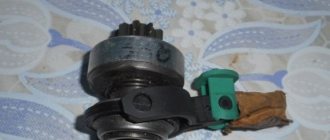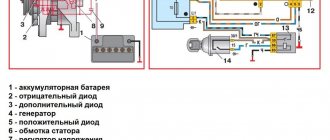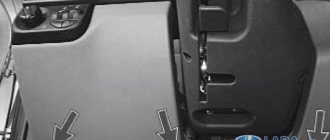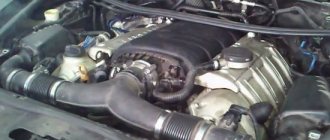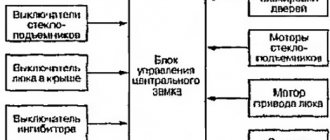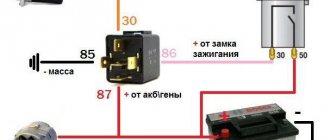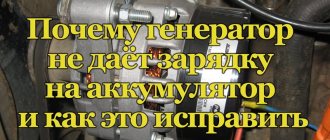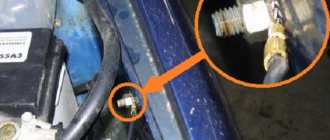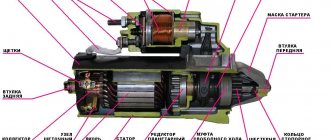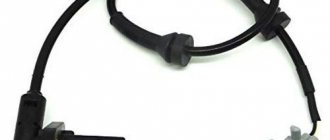The starter is one of the main links in the ignition system. The correct operation of this unit is responsible for starting the internal combustion engine. Reasons why the mechanism may fail: problems with the solenoid relay, discharged battery, opening of the ground contacts, ignition malfunction, violation of the integrity of the electrical wiring, etc. We will discuss the development mechanism, fault diagnosis and methods for eliminating them in more detail in the article.
Troubleshooting
You can often hear the phrase from car enthusiasts: “I get into the car, turn the key in the ignition, and nothing happens.” This occurs due to a breakdown of the starter unit or its electronics if:
- under the hood there are extraneous sounds (clicks, ringing, buzzing), but nothing happens;
- The engine will not start;
- The starter spins when starting, but the engine does not start;
- the crankshaft rotates slowly and the engine is silent;
- You can hear knocking noises under the hood, crackling gears and grinding noises.
Bendix problems
If the starter turns, but the engine does not start, then the bendix must be checked. First of all, you need to check its free movement in the longitudinal direction. If wedging is present, the overrunning clutch must be replaced.
On most starters, the gear rotates in only one direction. Therefore, they say about problems with the node:
- rotation with wedging;
- free movement in both directions.
The reason why the starter works normally, but the engine crankshaft does not rotate, may be wear on the Bendix gear. It does not engage the flywheel and, when sliding, does not transmit torque.
The most common causes of breakdowns
These are faults in the electrical circuit. These include:
- battery charge less than 12 V;
- oxidation of contacts;
- lack of current on the solenoid relay;
- breakage of the solenoid relay;
- wear of the brush assembly;
- armature commutator wear.
In the case when the retractor does not work and the starter is silent when the key is turned, the breakdown may be the result of a short circuit or open circuit to ground of the traction relay, or short circuit of the turn.
The culprit is electronics even if, when the ignition is activated and the engine starts, the flywheel disk rotates too slowly.
The mechanical causes of malfunctions can be judged by the lack of rotation of the crankshaft when the starter is working. When turning the key, the engine may not operate in the following cases:
- the slip clutch is broken;
- the release lever is faulty or disconnected from the axle;
- the buffer spring is worn out;
- Drive ring is broken or worn.
Simple and fast
The easiest way to deal with the power source is the battery. Sometimes it tends to run out of charge, and if it started to run out recently, you might not have noticed it yet. If you have a voltmeter tester, checking is a matter of seconds. If it is not there, you can use the old-fashioned method (although it is not very approved by firefighters): remove the wires from the terminals and rub them against each other.
There is a spark (which is why the firefighters are protesting) - the battery is working. If you don’t want to violate safety rules, just listen to the car’s reaction: a slight jolt at the first stage directly indicates a low battery.
The second reason, equally common and easy to eliminate, is their contamination. Clean them with a wire brush (probably lying in the trunk) - and the car will start.
The next thing to check is the fuses
. They often burn out, and most more or less modern cars have an ignition control. The circuit is removed from the glove compartment and it becomes clear which one needs to be checked; if it burns out, replace it, and that’s the end of it.
Lack of contact in the starter circuit
Occurs as a result of metal corrosion or loosening of bolted wires. In addition, you need to check the grounding of the retractor and main relay of the starter assembly. You can check your car's electronics using a multimeter. Before doing this, inspect the wiring, tighten the bolts and check the terminals. If there is contact loss, restore their integrity.
Problems with the starter armature
Problems with the armature are also common during starter operation. One of the main troubles is a breakdown on the body. It is easy to identify it by performing a “diagnosis” with a multimeter or ohmmeter.
In the absence of measuring instruments, the test can be performed using a light bulb, wires and a power source. You need to assemble the circuit shown in the image below. If current flows through the circuit and the light comes on, this means that the armature has become unusable and has a breakdown in the body.
Problems with the starter occur due to damage to the commutator. The reasons for this can be different, but most often associated with improper operation or exhaustion of the starter's resource.
Starting for too long leads to overheating of the plates. Small thermal defects can usually be removed by grinding. In case of significant damage, restoring the collector plate is impractical, so the armature must be replaced.
Why does the engine rotate inefficiently?
There are times when the starter works, but does not turn the engine with the required force. Let's list the situations when this happens:
- When using oil that does not correspond to the temperature conditions. The lubricant thickens and prevents the crankshaft from rotating. It is necessary to replace the lubricant with one regulated for the given weather conditions.
- Low battery charge. Does not provide energy for effective rotation. The battery needs to be recharged or replaced.
- In case of a malfunction of the brush assembly. It is necessary to check the contacts of the brushes and the tightening force of the tips going to the part.
How to fix a rattling starter
The method for troubleshooting depends on what is causing the problem. If the starter cannot work normally due to a discharged battery, it is enough to charge it to the required parameters. Typically, charging is carried out with a current of 0.1C, where C is the battery capacity in ampere-hours. At the same time, highly discharged current sources and calcium batteries should be charged with low currents (1-2 A) to at least 25% charge (this parameter is controlled by the density of the electrolyte). The gentle mode will take more time, but will protect the battery from many negative aspects.
Note! Often, when the battery is discharged, car owners try to start the engine “from a tow”. Note that this method is suitable only for the simplest power units, but not for injection engines
Launching the latter “from the pusher” often leads to a failure of the electronic control unit software.
In this case, the ECU begins to behave unpredictably - for example, request permission to start from a disabled immobilizer. The situation can only be corrected by reflashing the “brains”, and this, as you yourself understand, is an additional and completely unjustified expense.
In the case where the cracking of the solenoid relay occurs due to poor contact with the vehicle ground, it is enough to simply restore the electrical connection. To avoid problems in the future, it is recommended to remove the tire that connects the engine to the body and clean the contact pads with sandpaper. A thin layer of technical Vaseline or VD-40 universal lubricant will help prevent their oxidation.
If the source of the malfunction is the retaining winding of the starter solenoid relay, then try to repair it. If this is not possible, then a decision is made to replace the solenoid relay assembly. As you can see, even a novice driver can cope with finding the fault that is causing the starter to crack.
The mechanism does not function on a hot engine
The answer to the question of why the starter does not turn when hot lies on the surface. The bushings expand during engine operation, the unit begins to “wedge”, or it fails. As a rule, this problem occurs in cars with high mileage. Let's look at why this happens in the table.
| Cause of malfunction | Solution |
| Wear of standard bushings | Replacement |
| Bad contacts | Clean, tighten, treat contacts |
| Reducing the insulation resistance of the stator winding | Replace winding |
| Oxidized contact plates in the relay | Clean or replace |
| Foreign particles in the starter housing | Clean up |
| Brush assembly wear | Cleaning the brushes or replacing the unit |
VT with electric drive
Long-lasting operation, ease of manufacture and greater efficiency can be obtained by using an electric fuel pump, which is controlled by a special relay.
It allows you to create a pressure in the range of 0.3-0.4 MPa (in engines with direct injection - up to 0.7 MPa), which exceeds the capabilities of a mechanical HP. The device largely depends on where the fuel pump is located: in the tank or in the engine compartment. But the operating principle of all VTs of this type can be considered identical. The vast majority of modern cars use a submersible fuel pump, which is located in the tank. Although this is fraught with small mechanical losses and vulnerability associated with the long length of the fuel line, the pump receives much better cooling. During operation, the fuel washing the housing and passing through the electric motor removes a significant part of the heat. This is why driving with an almost empty tank affects the resource so much.
Device
An electric fuel pump consists of two parts: an electric drive (represents a conventional electric motor) and a pump part (pumps fuel from the fuel intake). Submersible pumps are placed in a single housing with a mesh that performs rough fuel cleaning.
Depending on the design of the intake mechanism, there are several types of pump parts:
- roller pump. Fuel is supplied by rotating a rotor with movable rollers. As the space between the roller and the rotor increases, a vacuum is created in the free space, which is filled with gasoline. With further rotation of the rotor, the space decreases, which allows pressure to be created and fuel to be supplied through the exhaust channel;
- gear fuel pump. The principle of operation is similar to the previous view, but changes in the area of free space occur due to the rotation of the gear;
- centrifugal pump. Fuel injection occurs due to vortex caused by the rotation of the impeller in the housing. The supply and removal of fuel is carried out through the corresponding channels inside the housing.
Operation logic
In cars in which the main life support components of the internal combustion engine are controlled via a CAN bus, the fuel pump receives the command to start from the electronic engine control unit. Before starting the internal combustion engine, it is necessary to create pressure in the fuel line, so immediately after turning on the ignition, the ECU sends a signal to the relay, which turns on the fuel pump. In some cars, power is supplied to the relay and the fuel pump is turned on when the driver's door is opened. The operating time of the fuel pump in this mode is calculated in seconds, after which the power is turned off. The subsequent start will occur when the starter begins to rotate.
Basic faults, simple diagnostics
The main breakdowns due to which the fuel pump may not work include:
- fuse blown;
- power failure, contact oxidation;
- wear of the brush assembly, as a result of which performance deteriorates, destruction of the commutator, wear of the rotor bushings;
- clogging;
- critical wear of rubbing pairs of roller and gear fuel pumps;
- destruction of the plastic coupling through which the armature shaft of the electric motor is connected to the pump rotor.
To understand why the fuel pump does not work, basic skills in using a multimeter are enough. The presence of power at the VT connector after turning on the ignition will indicate that the fault is in the pump. If power does not come and the fuel pump does not start, then you should check the circuit to the connector, as well as the relay.
Main symptoms of malfunction:
- increase in noise, appearance of extraneous sounds;
- failures when pressing the gas sharply;
- the engine periodically stalls (especially when hot);
- problems with starting.
Relay
One of the most important elements of the fuel injection engine power system is the fuel pump relay. It is used to reduce the load on the on-board network, since the power contacts are controlled by applying a low voltage to the corresponding terminals of the electromagnetic relay. Schematic diagram of connecting a fuel pump.
You can see the principle of operation of the relay, as well as testing methods in the video.
The part does not work either cold or hot
The reasons why the starter does not turn, does not start the vehicle and does not click may be:
- detachment of magnets;
- violation of the integrity of the contact group fuses;
- break in the control wire supplied to the starter. Carry out an emergency engine start. If it helps, the reason is in the ignition, if not, it’s in the wire;
- return spring failure.
Starter related problems
The main reasons are related specifically to the starter. There are quite a few elements susceptible to malfunction:
- Solenoid relay malfunction
- Contacts burning
- Bendix malfunction
- Gear wear
- Winding short circuit
The retractor relay moves the bendix until it engages with the flywheel. When the relay gets stuck, it stops moving and this is enough for the starter not to respond. To check, it is necessary to apply voltage directly to the power contacts. If it works, then that's the reason.
Poor operation of the solenoid relay, which causes it to click, is often caused by burning of the contacts. A very large current passes through them, so if they burn out, it is necessary to disassemble the relay and clean the contacts. However, this measure is only temporary, since these contacts are treated from the factory with a special coating, which wears off over time, and cleaning the contacts will only accelerate the wear process.
Bendix may also be the cause of the problem. To check it, you also need to close the contacts on the power relay. If the bendix is working properly, the rotor will rotate together with the bendix, but here it will be necessary to check the engagement of the gear with the flywheel. In addition, it is necessary to pay attention to the condition of the gear teeth and ring gear on the flywheel.
If they are worn or partially licked off, they may be slipping and not engaging well with each other. This malfunction will manifest itself in the form of a crackling sound when starting the engine or its free rotation without engagement with the flywheel. To ensure that the Bendix is working, the starter must be removed and manually checked for ease of movement of the gear.
Another reason may be a short circuit in the winding. In this case, even when voltage is applied directly to the starter contacts, it will remain silent. Removal and disassembly can confirm a short circuit.
The mechanism makes clicks but does not rotate
When the starter clicks once, but does not start the engine, this means that the unit requires repair. You need to try to start the car again. If it doesn't work, then it's probably the following:
- Bendix is broken;
- the starter winding is broken;
- a short circuit has occurred;
- the solenoid relay is faulty;
- brushes are worn out.
In this case, you need to replace the parts.
What is a starter
The starter is a DC electric motor combined with a retractor relay, which ensures its start and rotation of the crankshaft. In order to turn the crankshaft at a rotation speed that ensures the start of the working cycle, it is equipped with a motor of sufficiently high power, measured in kilowatts, and the required current for its operation can reach hundreds of amperes. Therefore, like any electromechanical device, the starter is subject to both electrical and mechanical failures.
Instructions for replacing the VAZ 2110 starter
To independently remove or replace a failed starter on a domestic car, you need to follow these simple steps:
- Remove the negative terminal from the battery.
- Disconnect the central wiring of the traction relay.
- Remove the positive terminal with a key set to “13”.
- Remove the nuts connecting the starter to the clutch.
- We remove the starter.
- Use a 10mm socket to unscrew the traction relay nut.
- The tip of the wire is removed.
- Using a 8 key, unscrew the bolts of the traction relay for removal.
- The gasket serving as a sealing connection between the cover, starter, and relay is removed.
- The anchor with the spring is removed from the central cover.
Such simple manipulations will make it possible to quickly and effectively dismantle the starter for further replacement or determine the breakdown, why the starter on the VAZ 2110 injector does not work. The removal procedure is not very complicated and does not require the intervention of a professional specialist.

